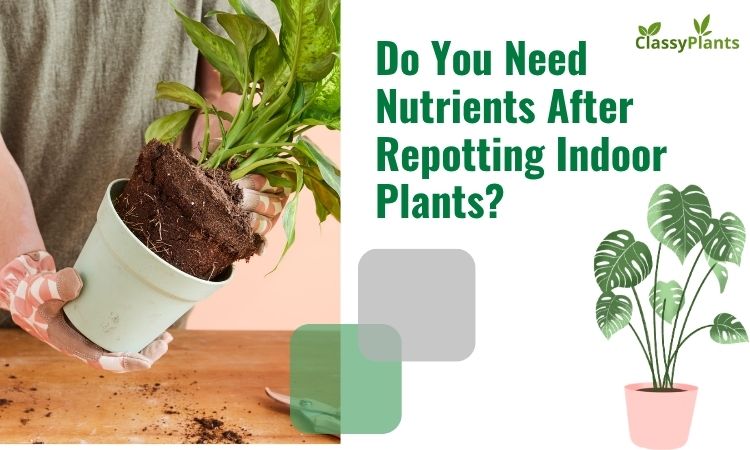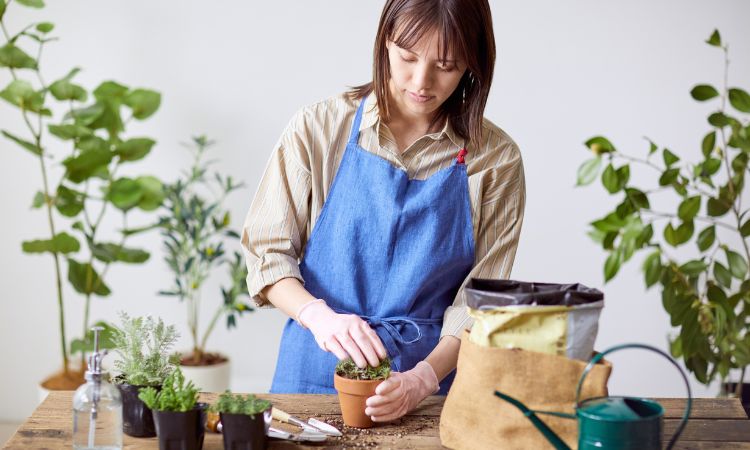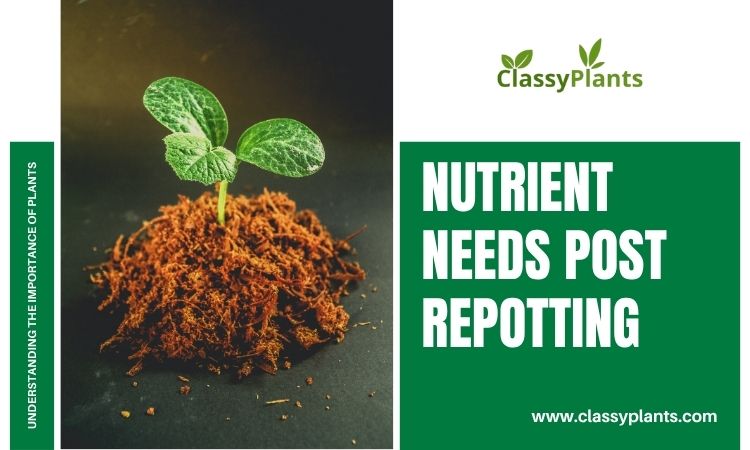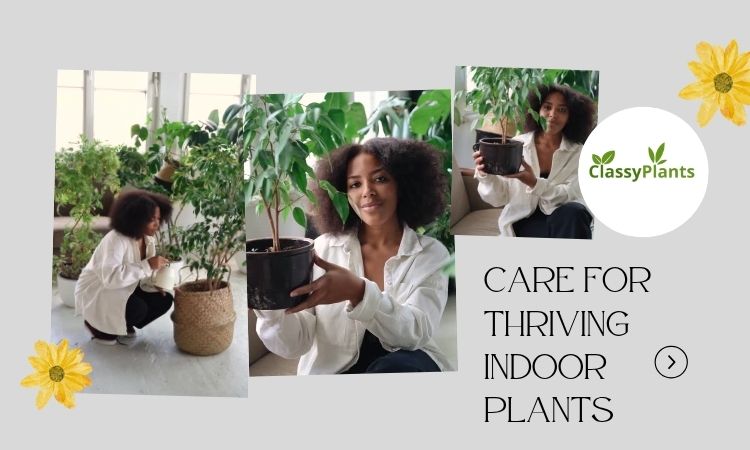Picture this: your trusty indoor plant, a thriving monstera, a delicate peace lily, or perhaps a spiky cactus, has outgrown its pot. You’ve picked out a sleek new container, mixed fresh soil, and carefully nestled your plant into its new home. As you admire your work, a question pops up: Do You Need Nutrients After Repotting Indoor Plants You want your green friend to keep flourishing, not just scrape by. Repotting is like a reset button for your plant, but getting the nutrient part right can make all the difference.

Why Repotting Matters for Indoor Plants
Repotting is more than just moving a plant to a larger pot. It’s about refreshing the soil, providing space for root growth, and addressing issues like root-bound plants or depleted nutrients. Indoor plants rely on the soil in their pots for essential nutrients, as they can’t access the broader ecosystem like outdoor plants. Over time, the soil’s nutrient content diminishes, which can stunt growth or cause yellowing leaves.
When you repot, you’re essentially giving your plant a fresh start. But does that fresh start include adding nutrients right away? Let’s explore the factors that influence whether your plant needs an extra boost after repotting.
Understanding Nutrient Needs Post-Repotting
The Role of Nutrients in Plant Health
Plants require three primary macronutrients, nitrogen (N), phosphorus (P), and potassium (K), along with secondary nutrients like calcium, magnesium, and sulfur, and trace micronutrients such as iron and zinc. These nutrients support critical functions:
- Nitrogen: Promotes lush, green foliage.
- Phosphorus: Encourages strong root development and flowering.
- Potassium: Enhances overall plant vigor and disease resistance.
When you repot, the new potting mix often contains a baseline of these nutrients, but the quality and composition of the soil mix can vary significantly.

Does New Potting Soil Have Enough Nutrients?
Most commercial potting mixes are pre-enriched with nutrients to support plant growth for a limited period. According to recent horticultural research (2025), high-quality potting soils typically contain slow-release fertilizers or organic matter that provide nutrients for 1–3 months. However, this depends on the brand and type of mix:
| Potting Mix Type | Nutrient Content | Duration of Nutrient Supply |
|---|---|---|
| General-purpose mix | Basic nutrients, often with slow-release fertilizer | 1–2 months |
| Organic potting mix | Organic matter (compost, peat) with natural nutrients | 2–3 months |
| Specialty mix (e.g., for orchids, cacti) | Tailored nutrients, often minimal | 1 month or less |
If you’re using a high-quality potting mix, your plant may not need additional nutrients immediately after repotting. However, low-quality or reused soil may lack sufficient nutrients, necessitating supplementation.
The Impact of Repotting Stress
Repotting can be stressful for plants. Disturbing the roots, changing the soil environment, and adjusting to a new pot can temporarily slow growth or cause transplant shock. Symptoms of transplant shock include:
- Wilting or drooping leaves
- Yellowing or dropping foliage
- Stunted growth for weeks after repotting
Adding nutrients too soon can exacerbate stress, as the plant may not be ready to absorb them efficiently. Experts recommend waiting 4–6 weeks before fertilizing to allow the plant to acclimate, unless specific conditions suggest otherwise.
When to Add Nutrients After Repotting
The decision to add nutrients depends on several factors, including the plant type, the potting mix, and the plant’s condition. Here’s a breakdown of when and how to provide nutrients post-repotting:
1. Assess the Plant’s Condition
If your plant shows signs of nutrient deficiency (e.g., pale leaves, slow growth), it may benefit from a light fertilizer application. However, these symptoms could also indicate transplant shock or overwatering, so diagnose carefully.
2. Consider the Potting Mix
If you’ve used a nutrient-rich mix, hold off on fertilizing for at least 4–6 weeks. For nutrient-poor mixes (like those for succulents or orchids), consider a diluted fertilizer after 2–3 weeks.
3. Plant Type Matters
Different plants have unique nutrient needs:
- Leafy plants (e.g., pothos, peace lily): Benefit from nitrogen-heavy fertilizers to support foliage growth.
- Flowering plants (e.g., African violet, orchid): Require phosphorus-rich fertilizers to encourage blooms.
- Succulents and cacti: Need minimal nutrients, as over-fertilizing can harm them.
4. Seasonal Timing
The time of year affects nutrient needs. Spring and summer are active growth periods, so plants may benefit from nutrients sooner after repotting. In fall and winter, most indoor plants enter dormancy, and fertilizing is often unnecessary.

How to Add Nutrients Safely After Repotting
If you determine that your plant needs nutrients, follow these best practices to avoid over-fertilization or further stress:
- Use a diluted fertilizer: Start with a half-strength solution of a balanced liquid fertilizer (e.g., 10-10-10 NPK) to avoid burning the roots.
- Choose the right type:
- Liquid fertilizers: Fast-acting and easy to dilute, ideal for immediate needs.
- Slow-release granules: Provide a steady nutrient supply over months, reducing the risk of over-fertilization.
- Organic options: Compost tea or fish emulsion can offer gentle, natural nutrients.
- Water thoroughly first: Ensure the soil is moist before applying fertilizer to aid absorption and prevent root burn.
- Monitor the plant: Watch for signs of over-fertilization, such as leaf burn or white crust on the soil surface, and adjust accordingly.
Common Mistakes to Avoid
Repotting and fertilizing go hand in hand, but missteps can harm your plants. Here are pitfalls to avoid:
- Fertilizing too soon: Adding nutrients immediately after repotting can overwhelm stressed roots.
- Using too much fertilizer: Over-fertilization can lead to salt buildup, which damages roots and leaves.
- Ignoring plant-specific needs: Not all plants require the same nutrients or feeding schedule.
- Poor soil choice: Low-quality or incorrect soil mixes can lead to nutrient deficiencies or drainage issues.
Long-Term Care for Thriving Indoor Plants
To ensure your indoor plants flourish after repotting, adopt a holistic care routine:
- Watering: Adjust watering based on the new pot size and soil type. Overwatering is a common issue post-repotting.
- Light: Ensure your plant gets the right amount of light for its species, as this affects nutrient uptake.
- Humidity and temperature: Most indoor plants prefer 40–60% humidity and temperatures between 65–75°F (18–24°C).
- Regular monitoring: Check for pests, nutrient deficiencies, or soil compaction over time.
By combining proper repotting techniques with thoughtful nutrient management, you can keep your indoor plants healthy and vibrant for years.

FAQs About Nutrients After Repotting Indoor Plants
Wait 4–6 weeks for most plants, as the new potting mix often provides enough nutrients initially. For nutrient-poor mixes or stressed plants, consider fertilizing lightly after 2–3 weeks.
No, different plants have unique needs. Leafy plants need nitrogen-heavy fertilizers, while flowering plants benefit from phosphorus-rich options. Always check the plant’s requirements.
Look for pale or yellowing leaves, slow growth, or weak stems. However, rule out transplant shock or overwatering before fertilizing.
Organic fertilizers like compost tea are gentler and less likely to cause root burn, making them a good choice post-repotting. Synthetic fertilizers work faster but require careful dilution.
Yes, over-fertilizing can cause root burn, leaf scorching, or salt buildup in the soil, leading to long-term damage. Always follow recommended dilution rates and schedules.
Conclusion
Repotting indoor plants is a critical step in their care, but adding nutrients afterward requires careful consideration. While high-quality potting mixes often provide enough nutrients for 1–3 months, specific plant needs, soil types, and seasonal factors can influence whether and when to fertilize. By waiting 4–6 weeks, using diluted fertilizers, and monitoring your plant’s health, you can support its recovery and growth without risking stress or damage.
For the best results, tailor your approach to your plant’s species and environment, and avoid common mistakes like over-fertilizing or using poor-quality soil. With these tips, your indoor plants will not only survive repotting but thrive in their new homes, bringing beauty and freshness to your space.